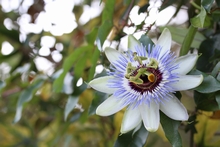Blue Passion Flower: A Symbol of Suffering - The Surprising Origins behind Paraguay's Floral Emblem
June 12, 2017

Hello again, Naho here. Time management is extremely important at work. I personally like keep a clock on my desk to remind me of how precious time is.
There is a flower that looks just like the dial of a clock, and that is the blue passion flower - which is also the floral emblem of Paraguay.
Surprisingly, however, this flower used to be associated with something distinctively different to a clock.
Blue Passion Flower: Symbol of Suffering?
With its petals resembling the short hand and the long hand of a clock, the blue passion flower looks just like a dial plate, which is why the flower is called "rokei-sou" (the clock plant) in Japanese. However, back in the day, the blue passion flower was often associated with something distinctively different.
The "passion" in "passion flower" does not mean "enthusiasm" in this context, but rather "suffering." This association came from the facts that petals of the flower form the shape of a halo and that its stamen and pistil look like the image of Jesus Christ bearing the Cross.
As a matter of fact, the missionaries who Christianized Paraguay used to hold a blue passion flower while preaching to the crowds, and it was therefore considered a flower of symbolic significance.
Paraguay's Deeply Rooted Christian Culture
During that time, Christian missionaries built promulgation settlements (reductions) across the country of Paraguay, and were actively engaged with the local residents. Among the large number of settlements, the ones in Trinidad and Jesus of south Paraguay together are listed as a UNESCO world heritage site. Built upon layers of brown stone bricks, the missions also feature beautiful carvings in the interior, which are of high artistic value.
In particular, the Jesús de Tavarangue mission was built by architects from Spain, who gave it a unique mixed style of both traditional Christian churches and Islamic architecture seen in Andalusia, Spain. The flower-shaped decorations on the entrance are also famous.
Additionally, a church located in the small town of Yaguarón is known for having a large painting of the passion flower on the ceiling. A long time ago, the passion flower was considered a symbol of protection and guidance. No wonder it is made to stand out by being painted on the church ceiling.
The Etymology and Different Meanings of the Word 'Passion'
It was mentioned earlier that the "passion" for "passion flower" signifies "suffering,", instead of the more commonly known meaning of 'enthusiasm.' In fact, the origin of the word "passion" comes from Latin "passus," which means "suffered," or "having suffered ."
The Japanese translation for "passion" is often "jōnetsu" and "gekijyō," meaning "enthusiasm" and "intense emotion." It is said that these definitions all came from the original meaning of "suffering" and the fact that extreme emotions often bring anguish and pain.
Passion can also mean "an outbreak of anger." In this case, the Japanese equivalents would be "katto okoru" (to get into a passion) or "gekidō shite iru" (to be in a passion). It is important to identify the exact meaning of "passion" before jumping ahead and translating it into other languages.
Related Services
| << Plum: Taiwan's Floral Emblem with Colorful Meanings | Rhododendron: Nepal's Floral Emblem - The True "Flower of the Heights" >> |
To Contact Us Regarding Our Translation Services
For urgent needs, call:
+81-3-5730-6133
